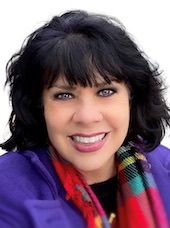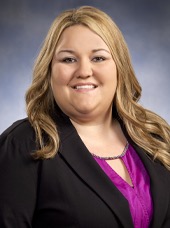Women face unique communication challenges—whether it’s uncertainty or a hesitancy to be candid. Here are some ways to become a bolder, more effective speaker.
Some people are natural public speakers. But for many, public speaking is something that creates a lot of fear. And fear, in turn, makes it difficult to do a great job presenting.
Dr. Susan Biali Haas, a physician, coach and wellness expert, has trained herself to do what seems out of reach for many—to feel calm, centered and even joyful while speaking. Writing for Psychology Today, she advises speakers to “Stand tall. Shoulders back, head up, eyes up and forward. … Adopt a posture that indicates that you’re present, focused and worthy of respect.”
And while it may seem obvious, she stresses the need for excellent preparation.
“Know your stuff, whenever you enter any important conversation, speech or meeting, ... more than just the superficial facts that you’re communicating,” writes Haas. “Prepare by going several layers deeper, if possible.”
Preparation, Focus and Clarity
Nothing can replace preparation; it’s one of the most crucial aspects a speaker can control to conquer fear and ensure success.
“For me, public speaking includes webinars, tutorial videos and phone calls with members,” says Laura Gibbs, online community engagement administrator for CUES, “and often, virtual presentations are just as nerve-wracking [as in person]. Being fully prepared is something I must do to walk in (or log in) to a meeting confidently.
“I make sure I’m well-versed in the subject matter, so I have a quick, direct and correct answer if any questions come my way. (And If I don’t know the answer, I’ll readily admit that.) Preparedness makes all the difference, whether I’m presenting to a few or several.”
For recorded presentations, Gibbs prefers to write and memorize a script. “Once I have it down, I practice flipping through the slides or demonstration if applicable. This gives me the confidence to navigate the presentation. I also record myself on video and watch it back.”
Such preparation will also benefit your audience. “Knowing your material and practicing your points can also help you to clarify your message and stay focused,” adds Laurie Maddalena, MBA, CSP, CPCC, CEO of CUES Supplier member Envision Excellence, Rockville, Maryland. “Avoid over-explaining or going too much into the details; this will muddy the message. Being clear and concise conveys your expertise and confidence.
“Also, be intentional with your message, whether formally presenting, prepping for a meeting or planning for a phone call. Focus on the audience to feel powerful and knowledgeable—like the expert you are.”

And if presenting uncomfortable news, don’t bury the lead, Maddalena advises. “Present difficult news first and offer a plan and supporting elements. Even for experienced communicators, addressing conflict can be difficult. Ask a trusted colleague to preview your presentation, find holes and think through the push-back so that you can prepare [a response]. If giving a presentation with a trusted colleague in the room, ask them to jump in for support or expand on your message, if appropriate.
“You have the experience, background and a unique perspective,” she notes. “Don’t concern yourself whether the audience likes you or not. ... Focus on seeking a connection rather than affirmation.”
Overcoming Challenges Unique to Women
Being treated equally has been a long-standing issue for women, says CUES member Deborah Fears, CUDE, president/CEO for $29 million Chicago Post Office Employees Credit Union. “[This can] lead to feelings of intimidation and make it difficult to project confidence. There’s also a perception that women ‘like to be liked,’ so we often downplay our thoughts or give in to power struggles in the boardroom.”
These feelings of inadequacy underscore the need for preparation. “Anticipate certain questions, and don’t be afraid to speak up and share your ideas and perspective,” Fears says. “Make sure you can articulate ideas clearly and effectively.
“If presenting to the board, get to know them outside of the boardroom. Building relationships makes it easier to address a group in a formal setting. Also, don’t compromise your personal brand,” cautions Fears. “You’ve worked hard to get to where you are, building a solid reputation based on your knowledge and skills. You didn’t get this role by accident; they hired you, so own it.”
Marketing consultant Deb McLean, CUDE, CDCFC, who has served credit unions for 20 years, suggests observing a board meeting in advance, if possible. “It’s beneficial for younger leaders to see how the board interacts, the structure of the meeting and personalities involved. Also, find a mentor who has a relationship with the board. Ask about their makeup—do they prefer stories or stats?”
Arnessa Belin, contact center supervisor and Black Alliance Cooperative lead chair for $25 billion BECU, Tukwila, Washington, offers another perspective on women’s struggles with speaking or presenting: “Seeing my mom and dad—who are both preachers—use their words with clarity and tone to capture attention and make points with confidence were my first lessons in clear communication. Unfortunately, many women have opposite experiences, groomed to have a more quiet, submissive voice, be palatable to others and work hard at being accepted.”
Fortunately, there are ways to retrain these ingrained tendencies to become a better, bolder communicator.

First, know your audience. “For example, when I’m speaking to the board, which may require getting out of my comfort zone, I adjust my style to be a bit more conservative,” says Belin. “Conversely, for a peer group, I relax my style. The key is to understand all relationships are different and pivot in your conversational style when needed.
“It starts with mindfulness while knowing your authentic self or identity,” she adds. “Realize there’s a difference between identity and personality; it’s your personality (not identity) you can adjust based on your audience or message.”
Next, silence the internal voice that interferes with your message. “I used to be timid around people of power, thinking I didn’t deserve to speak with them,” Belin reflects. “However, I made conscious steps to overcome this fear, telling myself: 1) I exist, 2) that person (of power) is a human first, and 3) something in their humanity matches mine. The bottom line is we’re more similar than different.
“But it may require you to open your heart and change how you see yourself,” Belin stresses. “Expand your circle and welcome everyone in. As I did this, … I realized I liked this version of myself better. Subsequently, my self-confidence grew, and so did my circle.”
Also, avoid comparing yourself with others, which can drain confidence. Focus instead on what makes you unique.
“This will help you to find your voice and identity,” says Belin. “It’s OK to view things differently. We can be mature enough to hear things that trouble us or [that we] disagree with. We can always learn, we can always teach, and we can always change our mind.”
Navigating the Chain of Command
Leadership consultant Michael Hudson, Ph.D., director of strategy & education for Aspire Leadership LLC, Delaware, says there is an unspoken power dynamic with people up and down the hierarchy. It can be subtle and is often ignored by the person holding power.
“For example, someone may word things a certain way depending upon how they view the other person, making it difficult to get to the issue at hand. It can emerge as a power struggle across the ranks, generations, or cultures—all of which can impact confidence, inhibit candor and dilute the message,” explains Hudson.
Set aside prejudgments that hinder communication, such as those based on age, experience and perspective.
There’s a perception that youth equals a lack of experience or competency, says Fears. “It can be difficult to get buy-in from older colleagues who may challenge your position strictly on age. Counteract this with preparation, by knowing your worth and that you have something important to say.”

Understanding communication styles can help, but it really starts with self-awareness, says Hudson.
“Women are naturally empathetic—good at responding in the moment—using their gift of empathy,” he notes. “However, this can sometimes lead empaths to rely too much on their ability to engage and respond when a more formulated, focused argument is needed. Superior preparation can counteract this inclination, help offset a power imbalance and boost confidence. This preparation is also essential for a conversation that’s going to happen, but you’re unsure when.”
Learning to master a point is another tool in speaking effortlessly and confidently. Hudson advises taking a formulaic approach:
- Identify the issue or problem.
- Define your solution.
- Craft your argument using evidence.
- Anticipate and resolve objections.
- Prepare your presentation.
- Practice your presentation.
- Respond confidently and directly to questions.
A speaker can use this formula over and over in any situation, he says.
How to Banish Fear
According to Verywellmind.com, as much as 77% of the population has some level of anxiety surrounding public speaking, or glossophobia.
To help tamp down anxiety, “practice with colleagues first—ask for a critique of your strengths and weaknesses,” says McLean. “If you find yourself getting nervous during the presentation, find a friendly face; it will help ground you.”
While there’s no substitute for experience in overcoming fear, there are ways to become a seasoned communicator faster.
“Push out of your comfort zone by giving yourself opportunities to practice your skills,” says McLean. “It may be serving on industry or other non-profit boards or presenting to organizations.”

Fears also views every day as an opportunity to communicate, including staff meetings, one-on-one conversations, even the person you meet in the grocery store.
Also, put yourself in a position of continual learning by watching TED Talks and YouTube videos, reading books, and more. “These can help you to better understand communicating with people and form ‘muscle memory,’ which enables you to stay quick on your feet,” Fears adds. She notes that Jason Dorsey is an excellent resource on communicating across generational divides.
McLean suggests watching the tone in your speaking voice, particularly if you’re younger. “Keep it low and modulated. Avoid pitching your voice higher at the end or making things sound like a question. Also eliminate slang (‘you guys’), qualifying language (‘but’),” and filler phrases and words that lessen clarity and message strength, such as “like,” “Does that make sense?” or “um.” To assist, avoid these undermining words and phrases.
Years ago, Fears says a mentor noticed her overusing the word “sorry.”
“I had to stop ‘apologizing’ for giving my perspective on issues,” she recalls. “If you’re not sure, practice in front of the mirror and record yourself; the playback can be a revelation.”
Bridging the Generation Gap
It’s been said “old souls” have a natural ability to connect across generations, understand the big picture faster and possess greater emotional agility. Belin, a self-professed old soul, says it’s the challenge of every generation to learn how to communicate with the next. “Still, it boils down to each of us having an open heart, being kind and respecting one another. And only by having an open heart can we become agents of change.”
As a millennial woman, Gibbs reflects that sometimes she doesn’t feel that she’s being taken seriously by older generations. “Empathy comes into play when I’m communicating with different generations—whether they’re older or younger than myself. Here, it’s important to know your audience and tailor your communication to stay relatable and authentic.”
Joining and learning from organizations like Toastmasters can help smooth some of the bumps along the way.
“I originally joined [Toastmasters] because I was nervous speaking up in meetings or with various age groups,” says Gibbs. “I was (and mostly still am) a listener and observer. But I learned a lot about myself, gained confidence and was able to refine my speaking skills based on audience.”

When communicating across the generations, McLean recommends working to stay grounded and calm, and connecting within yourself. “Whether you’re on the younger or older side of things, try to keep a sense of humor to alleviate tension, and remember—both sides can learn from one another.
“For millennials or Gen Z, recognize that older generations did the best they could with the resources they had,” she continues, noting that previous generations of women paved the way for women entering or advancing in the workplace today, but they faced greater limitations. “If you’re from an older generation, be willing to share and mentor younger generations—and be aware that new processes and philosophies improve work environments every day. Be open-minded and embrace change.”
McLean also suggests a bit of pop culture. For example, she and her Gen Z daughter have watched many movies featuring working women from various eras. “Together, we connect the generational dilemmas and gain greater empathy and understanding for women of another time.” (Here’s a list of “office movies” to explore, spanning eight decades.)
Most importantly: Don’t forget to listen.
“Age can be a factor when communicating—if you allow it to be,” says Fears. “However, a leader with effective communication skills will fare much better than one without. Be sincere in the way you approach communication across generations. Set the tone, be respectful of everyone, and leave the judgment at home.”
It may sound cliché, but respect is earned when respect is given, concludes Fears. “Being empathetic and aware of others’ emotions is not just critical to successful communication; it’s essential to being a leader.” cues icon
The Communication Checklist
Talented communicators will always:
- Know their audience, including age, background, and needs.
- Lean conservative with appearance, dress, verbal language and body language.
- Focus on excellent posture, make eye contact and speak assertively.
- Use clear, concise language.
- Be succinct in their points and avoid the anecdotal weeds.
- Avoid generalizations or qualifying language.
- Practice until the presentation is second nature.
- Ask one or two colleagues to preview and provide feedback.
- Alleviate technology hiccups ahead of time.
- Use simple visuals and do at least one run-through in the room where they’ll be presenting.
- Avoid seeking approval from the audience.
- Put away their phones.
Owner of Fab Prose & Professional Writing, Stephanie Schwenn Sebring assists credit unions, industry suppliers, and any company wanting great content and a clear brand voice. Follow her on Twitter @fabprose.






